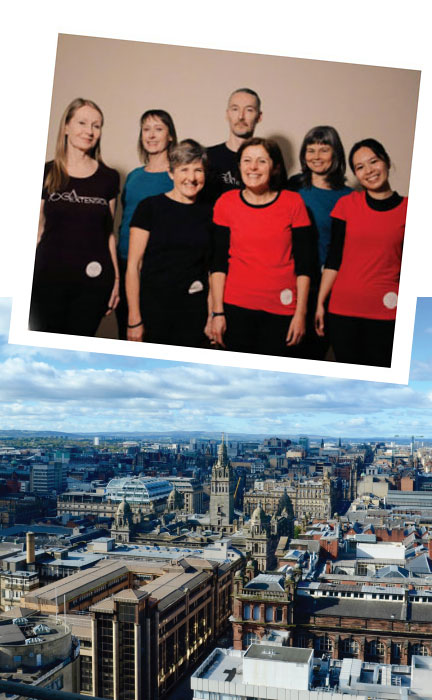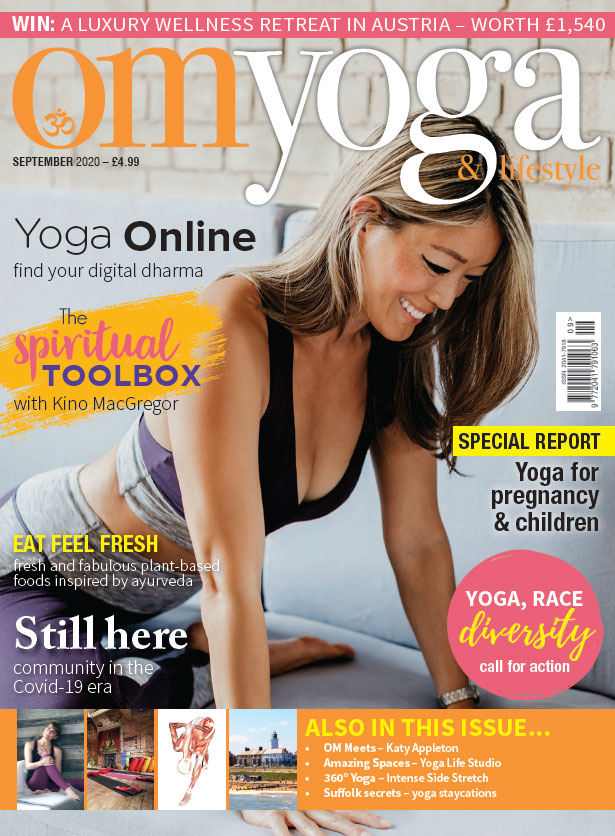
Live and kicking
Online yoga teaching sustains vital community spirit all around the globe. By David Holzer
When yoga studios around the world were told to close in March it had an immediate impact on the lives of the people who created them and their students. These are the stories of four studios in their own words.
Spain
Agnes Kru, the Yoga Hut,
Mallorca
“We started the Yoga Hut in mid-2018 in Binissalem, a tiny village between Mallorca’s wine country and the mountains. It’s a small space but we have access to a large outdoor area with a lawn. We offer Hatha, Vinyasa, Yin and Yoga Nidra as well as Qi Gong.
 When we went into lockdown, I started using Zoom. Another teacher recorded her classes and put them online on YouTube. Some teachers stopped completely.
When we went into lockdown, I started using Zoom. Another teacher recorded her classes and put them online on YouTube. Some teachers stopped completely.
I realised quickly that students needed the connection that came with my classes. Because they really wanted to see each other, nobody switched off their video. People were crying.
Now the situation is loosening in Mallorca studios can open again. We have hand sanitisers at the entrance to the studio. Everyone brings their own mats and props and they keep a safe distance apart from each other. But some teachers and students are still afraid and want to wait for a while.
I’m a teacher that loves to adjust. When we first opened again, I stayed on my mat and demonstrated poses and gave verbal instructions. Now I adjust physically - my students want it. In between adjustments I disinfect my hands. If someone doesn’t want to be adjusted, they place their mat a little apart from the main group.
Until it became too hot, I taught outside. It meant I could comply with the law and my students could feel safe. I’ll continue to teach outside until it gets too hot.
My students tell me that they now understand that yoga offers them the tools to cope with situations like the pandemic. It’s wonderful that they’re so deep into their practice. But some had difficult personal situations and just needed a hug.
I realised just how important it is to create a safe space for community and to be there for my students, in person now.”
Facebook: The Yoga Hut Binissalem
USA
Erica Morton Magill and Spiros Antonopoulos
Los Angeles Yoga Club
Erica: We founded Los Angeles Yoga Club to guide students towards greater awareness, resilience and stability by focusing on developing their personal practice. This means holding students in safety as much as we can while creating non-hierarchical communities of support and consent that diverge  from the deified guru model. Los Angeles went into ‘safer at home’ orders on 19 March but we closed on 13 March because we could see what was happening. Ours is a boutique shala with very little space between mats and we felt it wasn’t socially responsible to stay open.
from the deified guru model. Los Angeles went into ‘safer at home’ orders on 19 March but we closed on 13 March because we could see what was happening. Ours is a boutique shala with very little space between mats and we felt it wasn’t socially responsible to stay open.
Spiros: Erica worked in prisons in the Bay Area for over 10 years, teaching yoga mainly to incarcerated young women. This gave us a bit of insight into how people would feel under lockdown. Erica moved us online very quickly.
Erica: I felt it was super-important for people for continuity. Lockdown is obviously not prison but the trauma response of having social circles broken was similar. I knew we had to offer people a patterned, consistent rhythm that could hold them through their day.
Spiros: In the first instance, none of it was about money. It was purely about staying in touch with our community.
Erica: What’s been interesting is that because going online meant we could open up our space to a worldwide audience we haven’t suffered the same economic consequences that people in other fields have.
Scotland
Frances McKee,
The Yoga Extension, Glasgow
“I was in a band called The Vaselines. After they split for the first time, I trained as an Iyengar teacher. In 2006, I founded The Yoga Extension. When OM interviewed me before I said I didn’t want to offer online courses because, to me, yoga is a practical subject and all about physical connection.
 Although I’ve been teaching using Zoom, I still feel the same way. My students were really grateful I changed to online teaching so quickly. For me, teaching on Zoom is much more tiring than face to face.
Although I’ve been teaching using Zoom, I still feel the same way. My students were really grateful I changed to online teaching so quickly. For me, teaching on Zoom is much more tiring than face to face.
It’s because us yoga teachers get energy back from our students. With Zoom I’m teaching into a computer.
I’m teaching for my students who are really missing out on the studio community. Especially in the first few weeks of lockdown, when people booked into a yoga class every day, it was part of the routine that kept them functioning and shaped their week.
I have to say I also started to see the benefits of taking online classes. It was very nice to take classes with Abhijata Iyengar and my other teachers. I learned about online teaching by being the student. I’m grateful and relieved I’ve been able to keep going but, to be honest, it’s felt like going through stages of grief. This was the first year I felt I had things on an even keel with my studio and then, bam, total curveball.
Now we’re allowed to open, I think people will come because they appreciate community.
Whether having a yoga studio is going to continue to be a viable business if you can only have a limited number of people in a class, I don’t know. Perhaps the model will be offering face-to-face classes for people and having an online option as well.
Some studios have realised they can make more money offering classes online than they can with bricks and mortar. I do think a lot of teachers will decide just to continue online.
My feeling overall is let's step away from technology and be a community again.”
England
Jonathan Sattin,
triyoga, London
“I founded triyoga in 2000. We now have five centres in London. Each is designed to be a sanctuary away from the noise and bustle of London life. Our focus is providing the highest quality yoga classes, workshops and treatments possible.
We moved online after lockdown on 19 March, working mainly with Zoom and MBO. It was a new world to most of us but, as a community, we embraced and adapted to it.
 Our teachers learned by doing. They want to serve their community. It’s the same with our guest teachers. They’ve been offering workshops online from all over the world, whatever the time zone.
Our teachers learned by doing. They want to serve their community. It’s the same with our guest teachers. They’ve been offering workshops online from all over the world, whatever the time zone.
The feedback has been extraordinary. People in different parts of the world who did not have access to our incredible teachers now do.
Now that we’re open again, our goal is to make sure students are as safe as possible.
Front of house staff have visors which they will also wear in studios, plus gloves and aprons. All studios and mats are cleaned using the highest specified systems and materials before and after every class. We also have new sanitised high-spec filters in our air units.
Mats are spaced out to allow for social distancing. The number of classes is reduced by 50%.
Students have to pre-book and complete a Covid questionnaire to make sure it’s safe for them to practice with us. We check student temperatures and ask them to use a hand sanitiser before they enter our centres.
Looking ahead, it’s going to be a bumpy ride. We didn’t receive government assistance and we’ve had to invest in extra safety measures. We’ll run at a loss for quite a while.
At a time when studios all over London are closing down, we’re calling on the resilience and wider perspective yoga teaches us. We have a mission to serve and look after our people: students, teachers, therapists and staff. With all of us pulling together, we’ll navigate our way through.”


